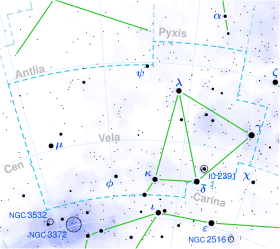| Observation data Epoch J2000.0 Equinox J2000.0 | |
|---|---|
| Constellation | Vela [1] |
| Right ascension | 08h 46m 01.64391s [2] |
| Declination | −46° 02′ 29.5042″ [2] |
| Apparent magnitude (V) | 3.87 [1] |
| Characteristics | |
| Spectral type | A1III [3] or A0 II [4] |
| B−V color index | 0.015±0.029 [1] |
| Astrometry | |
| Radial velocity (Rv) | +23.2±0.3 [1] km/s |
| Proper motion (μ) | RA: −12.82 [2] mas/yr Dec.: +4.23 [2] mas/yr |
| Parallax (π) | 1.76±0.14 mas [2] |
| Distance | 1,900 ± 100 ly (570 ± 50 pc) |
| Absolute magnitude (MV) | −4.89 [1] |
| Details | |
| Mass | 8.6±0.3 [5] M☉ |
| Radius | 41 [6] R☉ |
| Luminosity | 6,800 [6] L☉ |
| Temperature | 8,195 [6] K |
| Rotational velocity (v sin i) | 30 [7] km/s |
| Age | 30.6±2.6 [5] Myr |
| Other designations | |
| a Vel, CD−45°4517, HD 75063, HIP 43023, HR 3487, SAO 220422 [8] | |
| Database references | |
| SIMBAD | data |
HD 75063 is a single [9] star in the southern constellation of Vela. It has the Bayer designation of a Velorum, while HD 75063 is the identifier from the Henry Draper Catalogue. This is a naked-eye star with an apparent visual magnitude of 3.87 [1] and has a white hue. The star is located at a distance of approximately 1,900 light-years from the Sun based on parallax measurements and has an absolute magnitude of −4.89. [1] It is drifting further away with a radial velocity of +23 km/s. [1]
This object has been stellar classifications of A1III [3] and A0 II, [4] matching a massive A-type giant or bright giant star, respectively. It is an estimated 31 million years old [5] and is spinning with a projected rotational velocity of 30 km/s. [7] The star has 8.6 times the mass of the Sun [5] and around 4.5 times the Sun's radius. The star is radiating 6,800 times the Sun's luminosity from its photosphere at an effective temperature of 8,195 K . [5]
